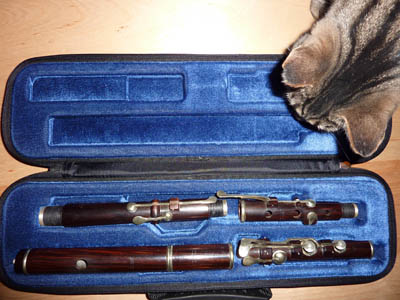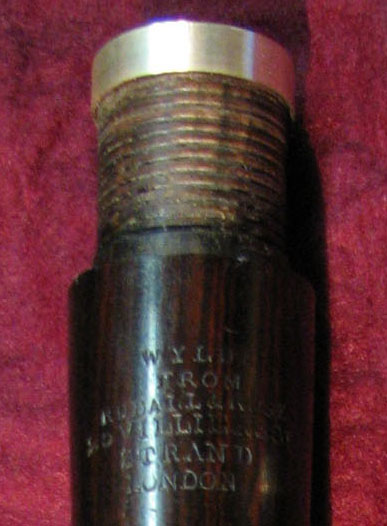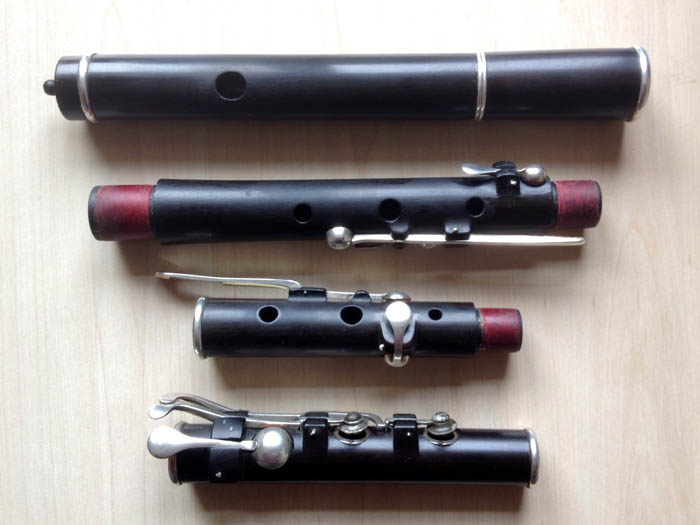I have often wondered about flutes made by former Rudall & Rose employees who later went on to manufacture them under their own names. People like; Henry Wylde, John & Thomas Ingram, Richard & George Payne, H. Whitaker and John & George Camp come to mind. Apart from keeping things in the family, what standard of craftsmanship were these men capable of achieving having left the " parent company. " How did their individual efforts compare with those made under the collective R.& R. banner?
It would be really interesting to hear the opinions and impressions from members who currently own, or have in the past
had the use of flutes made by any of these makers. 2TOOTS
"How did their individual efforts compare with those made under the collective R.& R. banner? " 2TOOTS.
I’d think that simple system flutes made under their own name would be as good as those stamped Rudall & Rose, Rudall, Rose & Carte or Rudall Carte & Co. I can’t imagine that flutes stamped with their own names would be of lesser quality than those supplied to Rudall? I haven’t played a Wylde myself but Claire Watts has one and it sounds great http://gerandclaire.com There’s a short video clip from Stabio, Switzerland where you can hear Claire playing in a group setting, couldn’t find a solo clip
This regarding Alexander Liddle from Terry’s site: http://www.mcgee-flutes.com/Liddle.htm
Dr. Robert Bigio, London maker and researcher, and world expert on Rudall Carte, advises:
Liddle occasionally supplied simple-system flutes to Rudall, Rose & Carte, who, from the late 1860s (and possibly before), bought in most of these instruments from other makers. The majority were bought in from Wylde, but some came from Liddle and some from other makers.
The mark-up on these flutes was huge: their cheapest 4 guinea flute (4 pounds 4 shillings) was bought in from Wylde for 1 pound 8 shillings. (One pound equals 20 shillings.)
Liddle flute here: http://www.loc.gov/item/dcmflute.0637
Hello Thomas, thank you for your insight about Alexander Liddle. I was aware that he had made keys for the Metzler company, but I had no idea that he had supplied Rudall, Rose & Carte with instruments. I notice that Liddle’s instruments, both those made for Metzler and under his own name appear to have slightly different aesthetics, such as the wide ferrules and rounded crowns. Wylde flutes seem to closely resemble instruments by Rudall & Rose.
It is not surprising that Rudall’s workers began to make instruments under their own name when one considers the staggering mark-up Between Wylde and Rudall Rose & Carte. Also, if flutes were being bought in from the workshops of Wylde and Liddle among others, could it be that earlier Rudall & Rose instruments were actually made by other makers? As a general observation, it seems that the flute-making community of 19th century London was fairly close knit and often interdependent.
It would be an interesting possibly revealing exercise to compare Rudall & Rose instruments with those of their former apprentices.
I have a Wylde, seems fine craftsmanship.
William Camp F (high-pitch, probably band flute) - meh.
Hello kkrell, could you give a more detailed description of the Wylde in question, especially its playing qualities. Also, if have you played a Rudall & Rose, could you give a comparison between the two. Having not played band flutes, I’d be interested to hear your own thoughts on the William Camp you have, I was under the impression that they are quite rare?
I’m not really sure what description would be useful. Uh… same as a Rudall and Rose, but marked “Wylde, from Rudall and Rose”.


May not be a fair comparison, anyway, as mine was firewood until Jon C. extensively rebuilt it. I have played a few R&R and they seem comparable, depending on hole size. I also have an early R&R, although I’m not certain all sections are original, as only the top hand section is marked.
As to the William Camp, it is still unrestored, and only partially playable. In my mind, it’s not as well constructed. I’m not putting any money into bringing it into shape, partly because of the pitch, and it’s boxwood, a bit ovalled, and needs a key mount graft and a couple of brass keys to put it in order. Know anyone making brass keys? I think Jon C. has only been working in sterling, or repairing German silver.

kkrell wrote: "I’m not really sure what description would be useful. Uh… same as a Rudall and Rose, but marked “Wylde, from Rudall and Rose”.
Nice pictures of the Wylde. Would you say you could see stylistic influences between your Wylde and your early Rudall & Rose? It is interesting that the Rudall & Rose flutes you have played are comparable. Hammy Hamilton’s book “The Irish Flute Player’s Handbook” gives Wylde as working on his own from 1831-1880, a career of 49 years, not counting his time with Rudall & Rose. Interesting, Wylde is listed in the book as “Wylde & Son.” Does anybody know at what time his son became involved with the operation and whether he took over his father’s business?
The Camp is a lovely looking instrument as well, especially in regards to the colouration of the boxwood, it seems to have aged nicely. I’m afraid I am not aware of any makers or restorers making brass keys. Maybe someone else on this forum could point you in the right direction.
Correct me if I am wrong - and I am sure somebody will !
Were Rudall’s outworkers not supplied by the “mother company” with wood for the bodies and keys etc. and the outworkers would make to the company specification. This could be a reason that the mark up in price is not as significant as we think as Rudall would be paying for labour only.
Just a thought.
Martin
Were Rudall’s outworkers not supplied by the “mother company” with wood for the bodies and keys etc. and the outworkers would make to the company specification.
You could be right but there is quantity to consider. Rudall would pay a rate for 1 and another rate for 20.
Rudall & Rose

Link to larger image: http://ravinecats.com/R&R2.jpg
The upper C touch is straight, vs. the end of the Wylde key being angled and flattened. BTW, I don’t believe I’ve seen any Wylde marked flutes later than the 1852 address at 25 Villiers St. (The Ingram & Morland address), yet Langwill lists other addresses through 1882.
The William Camp boxwood is probably nitric acid stained, not as a result of age.
About some of those other workers, Terry McGee has some mention on his page:
http://www.mcgee-flutes.com/Ruddal%20Workers.htm
Also interesting reading, and the reason behind my purchase of the William Camp flute:
http://www.mcgee-flutes.com/Rose%20vs%20Camp.htm
There is some interesting reading about production by apprentices and journeyman, still in Rudall Rose employ, parts supply and valuation, and possibly some outside processes, mentioned by Terry McGee on his page:
http://www.mcgee-flutes.com/Rose%20vs%20Camp.htm
One thought crosses my mind. Most early R. & R. models I have come across, came with silver keys and rings. A great deal of the ones I have observed made by the ex employees, although not exclusively, were adorned with the nickel silver variety, presumably to keep costs down and become more competitive. If this observation is accurate, it appears to have worked, as later R. & R. models seemed to have taken up the baton in this regard. Anyone available with more insight?
Kkrell - Out of the R. & R. and the Wylde, which one do you prefer to play, and Why ?
Anyone out there proud owners of; Ingram, Whitaker, or Payne flutes ? Can you give us the benefit of your experience ?
I own a Wylde and have played few R&R. I find that they have a different sound.
Flute making and a player’s choice of flute is about taste. My guess is that when working for R&R, Wylde was making flutes to reach the sound his bosses wanted, while when working alone he chose to follow his own favourite style.
I find that my Wylde has a more round, compact, refined, dark and lovely type of sound compared to some Rudalls I played, while the Rudalls sound full, strong, deep, with character. This is a subjective description.
I wouldn’t say one’s sound is superior to the other’s, they are just different.
About the attention to details in the making, it will also depend on the time they were made. Early flutes tend to be more pretty looking than later ones.
DIfferent Rudalls will sound different and I expect the same for different Wyldes.
Here is my latest Henry Wylde flute, it was made for Fentum, and is stamped on the foot H. Wylde.
This flute is beautiful Cocuswood and sports silver keys and rings. Also has double springs, and with the silver crown and foot ring, must have been the delux model. Plays as good as the best R&R flutes… (Of course I am the proud owner…) ![]()
LorenzoFlute wrote: “I own a Wylde and have played few R&R. I find that they have a different sound.”
Thank you for giving us the benefit of your impressions about your Wylde and R. & R. flutes you have played. Of the two, which would you say had the more focused sound? The first thing I pick up on when I play a flute, is whether the sound is focused or open, it seems an obvious facet.
Jon C. wrote: “This was an interesting Wylde I restored for Eilam a couple of years ago..”
Thanks for the great photos of these two interesting Wylde flutes. May I take a moment to complement you on your excellent restoration work. The second flute seems to be very elegant, it has a profile reminiscent of the Clementi Nicholson’s Improved model, but without the combing. Could it be that this is a somewhat earlier instrument than the former, and is there an address stamp to give us some indication? Did Wylde make flutes for Fentum? The consensus I seem to get, with Wylde flutes at least, is that they are on a par with Rudall & Rose instruments in quality and sound. Would you agree with this?
I think both of these flutes were from the same time period, I don’t have a date for the second one, mine was probably built for Fentum in the late 1830’s.
Well, I think my Fentum is the “smoking Gun” on the question if Wylde built for Fentum, being that he Wylde stamped his name on the foot… The keys are stamped I.N which were also used by R&R from that period.
Jon C. wrote: “Well, I think my Fentum is the “smoking Gun” on the question if Wylde built for Fentum,”
Wylde seems to have been a busy man! I notice the address on your Wylde/Fentum is at 78 Strand. At this time, Wylde had a new shop at Villiers Street, Strand, which could have made collaboration between the two convenient. Were the Fentums exclusively dealers, or did they also manufacture instruments themselves? Earlier in this thread, I mentioned the possibility of Henry Wylde having a son working with him. I wondered Jon if you had ever seen or worked on an instrument marked Wylde & Son?
Jon C. wrote: “The keys are stamped I.N which were also used by R&R from that period.”
The key marks on your Wylde/Fentum are also interesting. I had a quick look on Terry McGee’s website about I.N, but his real identity seems to be a bit of an enigma. Can anybody shed some light on who I.N may be? Also, are there any other ex Rudall & Rose employees that you may have come across or heard of?


